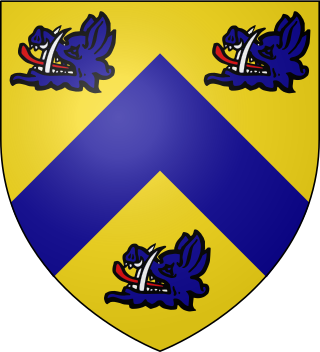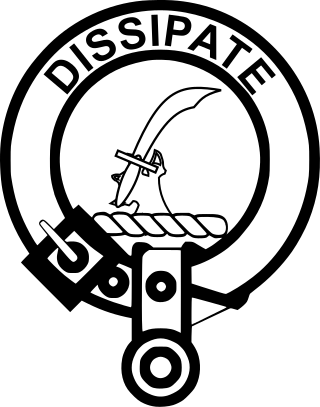
Duke of Atholl, named for Atholl in Scotland, is a title in the Peerage of Scotland held by the head of Clan Murray. It was created by Queen Anne in 1703 for John Murray, 2nd Marquess of Atholl, with a special remainder to the heir male of his father, the 1st Marquess.

John Graham, 7th of Claverhouse, 1st Viscount Dundee was a Scottish soldier and nobleman, a Tory and an Episcopalian. He was responsible for policing southwest Scotland during and after the religious unrest and rebellion of the late 17th century, and went on to lead the Jacobite rising of 1689.

Duke of Montrose is a title that has been created twice in the Peerage of Scotland. The title was created anew in 1707, for James Graham, 4th Marquess of Montrose, great-grandson of famed James Graham, 1st Marquess of Montrose. Montrose was elevated as a reward for his important support of the Act of Union. It has remained since then in the Graham family, tied to the chieftainship of Clan Graham.

Earl of Lindsay is a title in the Peerage of Scotland. It was created in 1633 for John Lindsay, 10th Lord Lindsay, who later inherited the ancient Earldom of Crawford. The two earldoms remained united until the death of the 22nd Earl of Crawford, also sixth Earl of Lindsay, in 1808. Then the earldom of Lindsay passed to David Lindsay, while the earldom of Crawford became dormant because no-one could prove a claim to the title until 1848. Both David, 7th Earl of Lindsay, and his successor Patrick, 8th Earl of Lindsay, died without sons, and the disputed claim over the earldom was resolved by the House of Lords in 1878 in favour of Sir John Trotter Bethune, 2nd Baronet.

Earl of Airlie is a title of the peerage in Scotland created on 2 April 1639 for James Ogilvy, 7th Lord Ogilvy of Airlie, along with the title “Lord Ogilvy of Alith and Lintrathen.” The title “Lord Ogilvy of Airlie” was then created on 28 April 1491.

The title Earl of Newburgh was created in the Peerage of Scotland in 1660 for James Livingston, 1st Viscount of Newburgh, along with the subsidiary titles Viscount of Kynnaird and Lord Levingston.

Earl of Dundee is a title in the Peerage of Scotland. It was created in 1660 for John Scrymgeour, 3rd Viscount Dudhope. At his death in 1668, the Duke of Lauderdale declared that the first Earl had no heirs-male, and had the crown seize all of his lands. The earldom of Dundee became dormant and its holdings and offices were granted to Charles Maitland, 3rd Earl of Lauderdale, the Duke's younger brother. The title was revived in 1953, when it was determined that the first Earl did indeed have heirs-male, contrary to the assertion of the crown. The title was given to Henry James Scrymgeour-Wedderburn, who had previously served in the House of Commons and in the Cabinet.

Earl of Rosebery is a title in the Peerage of Scotland created in 1703 for Archibald Primrose, 1st Viscount of Rosebery, with remainder to his issue male and female successively. Its name comes from Roseberry Topping, a hill near Archibald's wife's estates in Yorkshire. The current earl is Neil Primrose, 7th Earl of Rosebery.

Earl of Stair is a title in the Peerage of Scotland. It was created in 1703 for the lawyer and statesman John Dalrymple, 2nd Viscount of Stair.

Viscount of Oxfuird is a title in the Peerage of Scotland. It was created in 1651 for Sir James Makgill, 1st Baronet, along with the subsidiary title of Lord Makgill of Cousland, also in the Peerage of Scotland, with remainder to his "heirs male of tailzie and provision whomsoever". He had already been created a Baronet, of Makgill, in the Baronetage of Nova Scotia on 19 July 1625, with remainder to heirs male whatsoever. The remainder to heirs male whatsoever was a Scottish concept that permitted inheritance by persons not descended from the original grantee, but descended in the male line from male-line ancestors of the grantee. However, on the death of the first Viscount's son, the second Viscount, the Lordship and Viscountcy were assumed by his daughter Christian, as heir of tailzie and provision. Her son Robert Maitland Makgill also voted as Viscount of Oxfuird at the election of Scottish Representative Peers in 1733.

Lord Rollo, of Duncrub in the County of Perth, is a title in the Peerage of Scotland. It was created on 10 January 1651 for Sir Andrew Rollo. His great-great-grandson, the fifth Lord, was a Brigadier-General in the Army and fought in North America during the Seven Years' War. He died without surviving male issue and was succeeded by his younger brother, the sixth Lord. His grandson, the eighth Lord, sat in the House of Lords as a Scottish Representative Peer from 1841 to 1846. His son, the ninth Lord, was a Scottish Representative Peer from 1847 to 1852. His son, the tenth Lord, sat in the House of Lords as a Scottish Representative Peer from 1860 to 1868. On 29 June 1869 he was created Baron Dunning, of Dunning and Pitcairns in the County of Perth, in the Peerage of the United Kingdom. This title gave the Lords an automatic seat in the House of Lords. As of 2017 the titles are held by the tenth Lord's great-great-grandson, the fourteenth Lord, who succeeded his father in 1997. He is the hereditary Clan Chief of Clan Rollo.

Earl of Antrim is a title that has been created twice, both times in the Peerage of Ireland and both times for members of the MacDonnell family, originally of Scottish origins.

Earl of Caledon, of Caledon in the County of Tyrone, is a title in the Peerage of Ireland. It was created in 1800 for James Alexander, 1st Viscount Caledon. He was a merchant who had made an enormous fortune in India. He also represented the constituency of Londonderry City in the Irish House of Commons. Alexander had already been created Baron Caledon in 1790 and Viscount Caledon, of Caledon in the County of Tyrone, in 1797, also in the Peerage of Ireland. In 1784, James Alexander purchased a city house in Dublin at Rutland Square where he lived when serving as an MP for Derry.

Viscount Mountgarret is a title in the Peerage of Ireland.

Viscount of Stormont is a title in the Peerage of Scotland. It was created in 1621 by James VI for his friend and helper Sir David Murray who had saved him from the attack of the Earl of Gowrie in 1600. Murray had already been created Lord Scone, also in the Peerage of Scotland in 1605. The peerages were created with remainder to 1) Sir Mungo Murray, fourth son of John Murray, 1st Earl of Tullibardine, failing which to 2) John Murray, who was created Earl of Annandale in 1625, and failing which to 3) Sir Andrew Murray, who was created Lord Balvaird in 1641. Lord Stormont died childless and was succeeded according to the special remainder by the aforementioned Mungo Murray, the second Viscount. He died without male issue and was succeeded according to the special remainder by James Murray, 2nd Earl of Annandale, who now also became the third Viscount Stormont. He was the son of the aforementioned John Murray, 1st Earl of Annandale. He was also childless and on his death in 1658 the earldom became extinct.

The title Earl of Dunbar, also called Earl of Lothian or Earl of March, was the head of a comital lordship in south-eastern Scotland between the early 12th century and the early 15th century. The first man to use the title of Earl in this earldom was Gospatric II, Earl of Lothian, son of Gospatric, Earl of Northumbria. It descended to George de Dunbar, 11th Earl of March, who was forfeited by parliament of his titles & estates in 1435, and retired into obscurity in England. His son Patrick retained a barony at Kilconquhar in Fife.
The titles of Viscount of Melfort and Lord Drummond of Gillestoun were created in the Peerage of Scotland on 14 April 1685 for John Drummond, second son of James Drummond, 3rd Earl of Perth, with remainder to the heirs male of his body by his second marriage, to Euphemia Wallace, failing whom to the heirs male of his body whatsoever. He was further created, on 12 August 1686, Earl of Melfort, Viscount of Forth and Lord Drummond of Riccartoun, Castlemains and Gilstoun, also in the peerage of Scotland, and with a similar remainder.

Clan Scrymgeour is a Highland Scottish clan.
John Scrymgeour or Scrimgeour, 1st Viscount of Dudhope was a Scottish politician.
Viscount of Frendraught was a title in the Peerage of Scotland.










